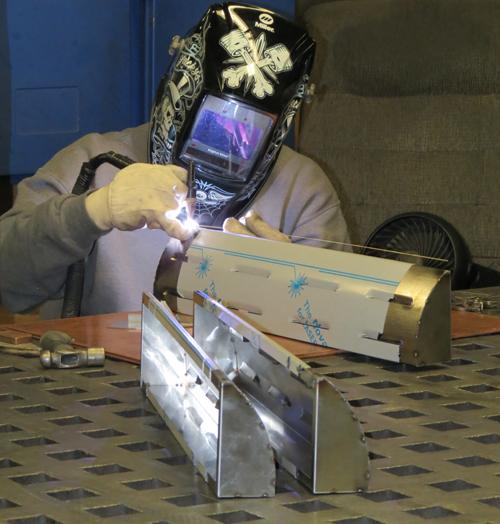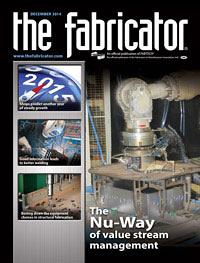Senior Editor
- FMA
- The Fabricator
- FABTECH
- Canadian Metalworking
Categories
- Additive Manufacturing
- Aluminum Welding
- Arc Welding
- Assembly and Joining
- Automation and Robotics
- Bending and Forming
- Consumables
- Cutting and Weld Prep
- Electric Vehicles
- En Español
- Finishing
- Hydroforming
- Laser Cutting
- Laser Welding
- Machining
- Manufacturing Software
- Materials Handling
- Metals/Materials
- Oxyfuel Cutting
- Plasma Cutting
- Power Tools
- Punching and Other Holemaking
- Roll Forming
- Safety
- Sawing
- Shearing
- Shop Management
- Testing and Measuring
- Tube and Pipe Fabrication
- Tube and Pipe Production
- Waterjet Cutting
Industry Directory
Webcasts
Podcasts
FAB 40
Advertise
Subscribe
Account Login
Search
One metal fabricator, two value streams
How Nu-Way Industries manages two business models under one roof
- By Tim Heston
- December 12, 2014
- Article
- Automation and Robotics

Figure 1
Nu-Way’s flexible manufacturing system is central to the fabricator’s make-to-stock value stream.
Not long after the telecom bubble burst, Nu-Way Industries made a bold move in 2002 by building a 62,000-square-foot addition and filling it with quintessential, full-out automation. The Des Plaines, Ill., fabricator was ready to compete with the world.
Only a handful of people are needed to run this massive expanse of machinery. A Prima Power flexible manufacturing system (FMS) sends raw stock to one of a series of cutting systems: two punch/laser combination machines and a punch/shear combination system (see Figure 1). It then retrieves cut parts and sends them to one of two automatic panel benders that, thanks to having a deep throat behind their bend tooling, can form tall flanges (see Figure 2); one panel bender in the FMS can form flanges up to 8 inches tall, the other forms flanges up to 10 in.
After forming, the FMS sends parts via conveyor to hardware insertion and then on to where a material handling robot picks up the formed enclosures and positions them under a remote laser welding beam with a focal length measured in feet. Scanning mirrors in the Rofin CO2 system send the beam from one weld to the next in milliseconds. A little more than 30 seconds later, the enclosure emerges fully welded (see Figure 3). The laser is so fast that welding actually outpaces bending. So the cycle time for this product is set to the constraint process, the panel bender, itself an extremely fast machine.
Nu-Way calls its addition the Automation Center, and it remains a showpiece of flexible manufacturing, producing different subassemblies that make up about 36 SKUs in their entirety, save for the powder coating and final assembly. Other SKUs that aren’t a fit for laser welding go to a nearby team that operates a series of resistance spot welders. After packaging, the parts are sent to several rows of finished-goods stock that sit adjacent to the FMS—a quick-response, make-to-stock replenishment in which customers pulling from inventory trigger the production cycle.
The Automation Center addition is connected to Nu-Way’s original plant, an old Hughes Aircraft facility, where most of the fabricator’s 260 employees work. The original building has advanced equipment, but for the most part it’s organized departmentally, in job shop fashion (see Figure 4).
The original shop has a stand-alone panel bender (see Figure 5), robotic arc welding machine, a fiber laser robotic welding cell, and even another remote laser beam welding cell with robotic material handling and fixturing. If you’re at a Subway and see a speed-cook oven behind the counter, there’s a good chance it came from Nu-Way, where an articulating robot arm grasped its enclosure and positioned it under a long-focal-length laser beam to seal the cavity.
Nu-Way fabricates both engineered-to-order and make-to-stock jobs, a common situation among large fabricators. Recently, though, managers realized that “make-to-stock” and “engineer-to-order” weren’t just descriptive phrases for a job type. They were, in fact, different business models that warranted two separate approaches.
Over the past three years, Nu-Way managers have restructured the organization to better reflect this reality. They’re doing it by separating the company into two value streams, one focusing on engineered-to-order items and the other on make-to-stock.
Foundation of Contract Work
Brothers Joe and George Howard launched Nu-Way as a little garage welding shop in 1968, when neither could have imagined anything like remote laser beam welding. They grew their company over the decades with all the signature custom fabrication equipment, and they evolved into a contract shop with longtime customer relationships.
Nu-Way saw its first big wave of expansion in the 1980s, when it became a supplier to agriculture and construction OEMs. In the mid-1990s came the move into its current facility in Des Plaines, followed by explosive growth thanks to the telecom boom. With the large contracts came great rewards but also risk, which became glaringly apparent after the 2001 bubble burst. The telecom giants pulled back and sent their remaining work overseas.
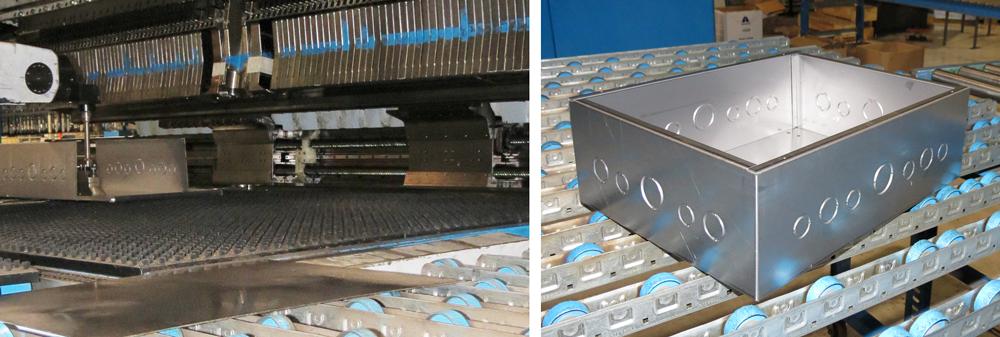
Figure 2
The company’s panel benders are designed with deep throats that allow them to form tall flanges.
This is when Nu-Way moved against the grain and made a bold move toward automation and that 62,000-sq.-ft. expansion, making for a total of 300,000 sq. ft. of manufacturing space. Managers knew they needed to compete with the China price, and they also knew they needed to diversify their contract work.
One large industrial enclosure customer in the late 1990s began to send a portion of its work overseas, but Nu-Way maintained the relationship by offering inspection and stocking services for the product the customer was bringing in from Asia. After two years, though, the customer found that it was costing more to produce the product in Asia than anticipated, and subpar quality made it even costlier.
So the customer started talking with Nu-Way again about manufacturing. It wanted to bring the business back, though for a lower price than the fabricator offered in the 1990s. Managers realized that to meet that price required automation, and from this came Nu-Way’s FMS investment.
The OEM’s work filled about 30 percent of the FMS’s available capacity, and Nu-Way filled a portion of the rest with existing work from the shop that fit the new equipment. The FMS gave the fabricator capacity that few could offer, so it wasn’t long before more work came in the door, including some from major companies in commercial food service, medical equipment, and residential appliances.
Commercial food service equipment remains Nu-Way’s largest sector in its customer portfolio. The top three commercial food service accounts provide the fabricator with about a quarter of its revenue. Before long Nu-Way added machines and towers to handle the increased demand, and today the FMS is about twice as large as it was a decade ago. The tower now holds 230 cassettes and spans the length of the building.
The FMS shortened manufacturing time dramatically, which is critical in a make-to-stock environment. If it takes mere hours or days to make a significant amount of products, there’s no need to keep months’ worth of finished-goods inventory.
Identifying the Value Streams
“This place could never survive strictly as a job shop. For the past 15 years we’ve had the 80-20 rule apply here. We have about a dozen customers that generate about 85 percent of our revenue, and another 120 customers that generate the balance.”
So said Steve Wiseman, executive vice president of operations. For years the company had its make-to-stock agreements that spelled out various aspects of the job, such as forecasts and inventory stocking and replenishment levels. The remaining business involved customers with engineered-to-order products—that is, the job shop business. But the company structure didn’t match this situation. It was still operating as one business, but in reality, it was two.
“Up until recently we didn’t even attempt to distinguish the difference between our job shop business and our make-to-stock business,” Wiseman said. “We took replenishment orders for make-to-stock, we took customer purchase orders for the engineered-to-order product, and we tried to schedule it all through the same equipment and resources.”
This created production challenges that most fabricators are all too familiar with, as they deal with greater-than-anticipated demand from one customer while trying not to push other orders behind. Managers dealt with the situation piecemeal, such as by putting together customer-specific workcells, but there certainly wasn’t a companywide effort to distinguish the two very different types of orders Nu-Way processed.
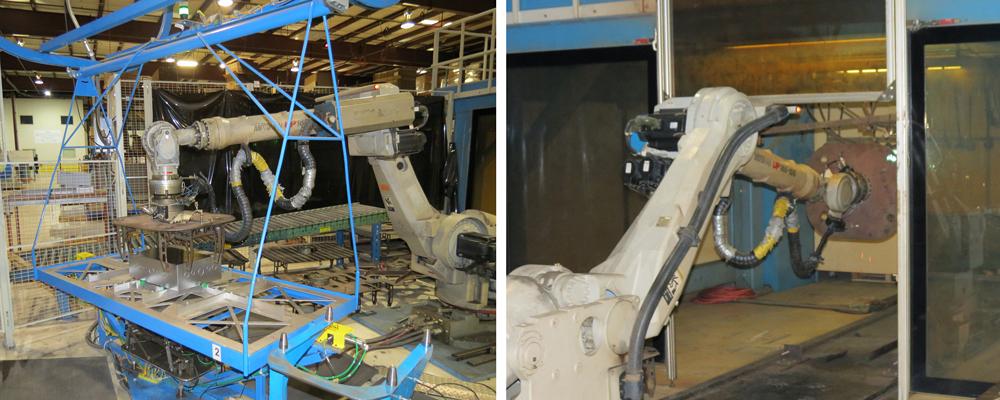
Figure 3
A part is conveyed to the remote laser welding cell, where a robot retrieves it and positions it under the laser beam. The total welding cycle time is a little more than 30 seconds.
Three years ago the company hired Michael Westbrook, director of operational excellence, and last year they hired a new director of operations, Ken Keafer. Two months ago the company brought in Joe Fijak as executive vice president of sales and marketing. Within the past year these three, along with Wiseman and other company leaders, analyzed Nu-Way’s customer base and determined which products were engineered-to-order and which were made-to-stock.
Some engineer-to-order jobs may produce higher sales volume than make-to-stock work. It’s the contract—stating that the customer will buy the inventory, and that Nu-Way will maintain that inventory at an agreed-upon level—that sets the make-to-stock work apart.
The team mapped out manufacturing, from order processing in the front office to packaging and shipping at the loading dock. After much analysis, Wiseman said, the team came to a realization. “We knew we couldn’t operate the way we were operating and be the type of company we wanted to be.”
From these meetings came the beginnings of Nu-Way’s two value streams, each with a personnel structure that includes value stream managers who report to senior company leaders. Operators, purchasers, planners, inventory personnel, and others all now are dedicated to specific value streams.
Westbrook spent a good portion of his time last year replacing the fabricator’s 25-year-old enterprise resource planning (ERP) system with a new system that’s now tailored to the two-value-stream approach. The system has integrated customer relationship management (CRM), shop floor management, and financial reporting.
A work order is designated as an “engineer-to-order” or “make-to-stock” value stream from the get-go. This designation affects how the order is processed through the system, and what information goes where. “When make-to-stock releases come in, it’s fairly automatic, and it flows right through to our planning department for them to prepare stock replenishment jobs for the shop floor,” Westbrook said. “In fact, we’re putting in a cell right now that will be triggered directly with pull signals from our finished-goods inventory. The planning and job creation work in the front office basically goes away.”
On the engineer-to-order side, the shop can receive previously run repeat orders that engineering reviews to ensure designs are accurate and up-to-date. New engineer-to-order jobs, of course, are sent through the entire engineering process.
“New jobs really start with a quote request, which is fully engineered by our estimating group,” Westbrook said. “Then when the [engineered-to-order] sales order comes in, engineers can pull those details from the quote.”
Whether it’s new or repeat work, if a job is coded engineered-to-order, engineers have a dashboard on their ERP screen showing those jobs in the pipeline.High-product-mix Part Flow
If a nonrepeat job has sufficient volume, planners no longer automatically send it to the FMS. An order may have extremely high volume, but it may be here today and gone tomorrow, and that’s not ideal for keeping a massive piece of automation busy over the long term. “We now have a much more disciplined approach as to what kind of work is sent to the FMS, based on the equipment’s capabilities,” Wiseman said, “and whether the job fits the make-to-stock model.”

Figure 4
The original factory does have a few workcells dedicated to certain products, but for the most part it’s organized in a traditional department fashion. The forming department processes various jobs, though the shop is in the process of transferring more make-to-stock work to either the FMS or dedicated workcells.
“With our make-to-stock items we have repetitive pull systems, and they need highly repetitive timing,” Westbrook added. “If you have a weekly replenishment, you have to run those parts every single week. If you load big groups of other jobs on the system at one time, it can throw off the pull system entirely.”
This exemplifies the complexities of custom fabrication. If Nu-Way’s product mix were low and demand perfectly consistent, a traditional value stream arrangement might work on the shop floor. You could imagine two color-coded manufacturing lines, work-in-process flowing continually between processes, with no shared resources whatsoever. All the engineer-to-order work would flow through the stand-alone machines in one value stream, while the make-to-stock orders would flow through the FMS in the Automation Center.
The company is making moves toward this ideal, transferring more make-to-stock items to the Automation Center when and where it makes sense. The center also has its own engineering and quality departments.
Like so much in custom fabrication, though, the situation isn’t straightforward. Managers do what makes sense for the product mix, demand level, job schedule, and available capacity. If an engineer-to-order job can be made faster on the FMS, production managers occasionally send a job there, as long as the FMS has available capacity and it doesn’t throw off the cadence of make-to-stock work.
Conversely, if a make-to-stock job isn’t a good fit for the Automation Center yet has demand that’s consistent enough to warrant its own fabrication cell, Nu-Way makes it happen. Say a certain weld seam has line-of-sight problems for remote laser beam welding; the shop’s robotic fiber laser welding cell might be a better fit (see Figure 6).
The FMS could cut and form the components in no time flat, and with little labor input. But because the job requires welding with the fiber laser, the excess travel time between workcells would cancel out any efficiency gains. Global efficiency (shortening total manufacturing time) trumps the local efficiency of the FMS (extraordinarily fast cutting and bending), which is why in this case a manufacturing cell that includes fiber laser welding is appropriate.
The key, Westbrook said, has been to assign dedicated resources where it is logical—for make-to-stock work that’s highly repetitive and mature in the product life cycle, so there’s less chance of a major design change. “We try to carve out as much as we can to dedicate these systems for that repetitive make-to-stock work, so we can free up the other shared resources for the discrete orders.”
Of course, shared manufacturing resources are a fact of life for a custom fabricator. By its nature, powder coating will remain a shared resource, though the lines are strategically placed at the end of the original factory, adjacent to both final assembly and the Automation Center. Parts from both the original factory and the FMS flow to powder coating, then to final assembly and packaging, before either shipping out the door or going into stock.
Because some resources need to be shared, moving machinery gets complicated. Sure, the company could move some machinery to make dedicated cells near its Automation Center, to physically separate the value streams. But a few of those machines may be shared among several SKUs, some engineer-to-order and others make-to-stock. Is it possible to change job routings to reduce shared resources? Sometimes yes, sometimes no. Managers need to make careful chess moves, and the mix of products continually changes the board.
Cross Training
Engineered-to-order work isn’t as predictable as the make-to-stock side. Still, the company rarely hires any temporary workers, save for the occasional high-volume assembly job. To make this possible the fabricator has implemented cross-training programs to account for variability in demand. For instance, Nu-Way certifies its welders to American Welding Society standards (see Figure 7), so they’re extremely skilled. But, of course, they’re not adding much value if they don’t have much to weld.
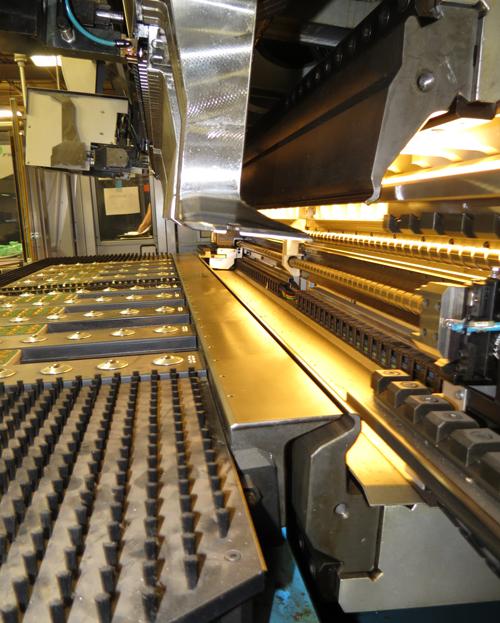
Figure 5
The original factory has various advanced machines, including a stand-alone panel bender. The operator places the material against the locating pins and the machine performs the bend.
“We may have a heavy arc welding month, and the following month we may have more spot welding,” said Keafer. “So we have cross training so people can move to where the constraint is, so we don’t need to increase our head count or work additional hours.
“I’m a theory of constraints guy,” Keafer added. “You can run machines forever and put parts on the floor, but the parts aren’t going anywhere, so they’re not doing us any good.”
Sales Strategy
At about $42 million, annual revenue is actually down from where it was eight years ago, but profitability is up, and so is the diversity of Nu-Way’s customer portfolio. The company has ramped up its sales and marketing efforts to find complementary work in various sectors. For instance, the shop has extra capacity in electronics assembly and stamping, so the sales team is focusing its efforts on bringing in that type of work.
In addition, Joe Fijak has brought an entirely new approach to the sales and marketing efforts with the recent hiring of new business development managers, working with a large rep organization and a network of contacts.
“Nu-Way is working toward establishing partners in industries that would not have been considered years or even months ago,” said Fijak. “You will find Nu-Way engineered and manufactured products throughout the world, including North and South America, Europe, Asia, and India.”
According to Wiseman, ideally Nu-Way would like to have no one market segment make up more than 20 percent of revenue, and no one customer make up more than 10 percent. “Of course, this is just an ideal, and just like everyone else, we’re opportunistic,” Wiseman said. “We don’t turn down a big order just because we have too much business in that market segment. But long term, we want to spread our work out.”
He added that he’s looking to share more information between sales and the rest of the organization. The company now has more cross-functional meetings, including weekly calls with updates from the sales staff.
All managers have a real-time dashboard that shows current and upcoming quote activity and projected revenue levels. “We’re trying to do a better job at preparing for what’s coming, so we’re not as surprised as we were in the past,” Wiseman said.
Set for Lean
Westbrook pointed to an area with brakes and hardware-insertion machines. That’s where he envisions a first-in first-out (FIFO) lane for certain engineered-to-order products. Keafer pointed to machines that will be moved; kanban boards for replenishment items; and metric boards showing preventive maintenance, key performance indicators, and other beginnings of a lean initiative.
Plans are to move toward a visual factory, with live screens showing job status and schedules. Eventually the entire operation may say goodbye to paper travelers and go paperless, with each worker scanning bar codes to bring up a job file on their laptop or tablet, complete with standard work instructions, the latest drawing, inspection information, and more.
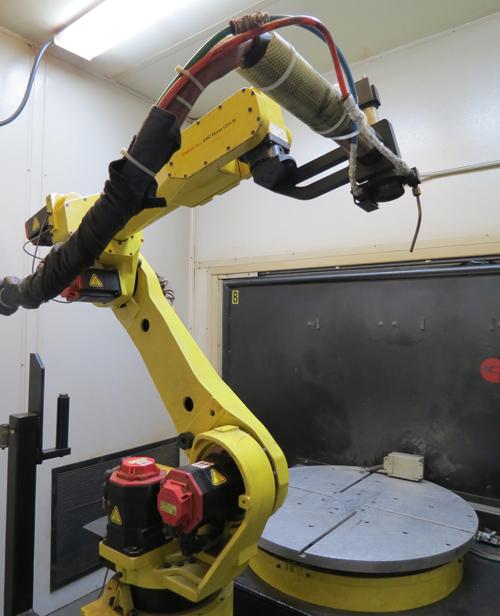
Figure 6
For some parts, this fiber laser welding cell, with its flexible joint access, is a better fit than the company’s remote laser beam welding.
The stage for lean, it seems, has been set.
“From a value stream perspective, we now have more structure,” Wiseman said. “We’re starting to do kaizen events, and now we can start looking at incorporating some of that lean culture into those value streams.”
About the Author

Tim Heston
2135 Point Blvd
Elgin, IL 60123
815-381-1314
Tim Heston, The Fabricator's senior editor, has covered the metal fabrication industry since 1998, starting his career at the American Welding Society's Welding Journal. Since then he has covered the full range of metal fabrication processes, from stamping, bending, and cutting to grinding and polishing. He joined The Fabricator's staff in October 2007.
Related Companies
subscribe now

The Fabricator is North America's leading magazine for the metal forming and fabricating industry. The magazine delivers the news, technical articles, and case histories that enable fabricators to do their jobs more efficiently. The Fabricator has served the industry since 1970.
start your free subscription- Stay connected from anywhere

Easily access valuable industry resources now with full access to the digital edition of The Fabricator.

Easily access valuable industry resources now with full access to the digital edition of The Welder.

Easily access valuable industry resources now with full access to the digital edition of The Tube and Pipe Journal.
- Podcasting
- Podcast:
- The Fabricator Podcast
- Published:
- 04/16/2024
- Running Time:
- 63:29
In this episode of The Fabricator Podcast, Caleb Chamberlain, co-founder and CEO of OSH Cut, discusses his company’s...
- Trending Articles
Capturing, recording equipment inspection data for FMEA

Tips for creating sheet metal tubes with perforations

Are two heads better than one in fiber laser cutting?

Supporting the metal fabricating industry through FMA

Hypertherm Associates implements Rapyuta Robotics AMRs in warehouse

- Industry Events
16th Annual Safety Conference
- April 30 - May 1, 2024
- Elgin,
Pipe and Tube Conference
- May 21 - 22, 2024
- Omaha, NE
World-Class Roll Forming Workshop
- June 5 - 6, 2024
- Louisville, KY
Advanced Laser Application Workshop
- June 25 - 27, 2024
- Novi, MI
























